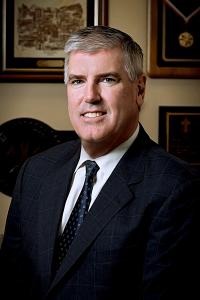
Q: Is it true that people are more at risk for suicidal thinking during the holiday season?
A: We commonly hear that people may be more at risk for suicide during the holidays; however, research does not support this idea. While it’s true that the holiday season may be particularly stressful for some people if they are socially isolated, experiencing conflicts in important relationships, dealing with financial challenges, or experiencing other psychosocial stressors, we do not typically see an increase in suicidal thinking during the holidays. Regardless of the season, anyone experiencing emotional distress or thoughts of suicide should reach out for support by calling the National Suicide Prevention Lifeline at 800-273-TALK.
Q: I’ve heard that sometimes people feel more depressed in the winter. Can you tell me more about Seasonal Affective Disorder (SAD)?
A: Seasonal Affective Disorder (SAD) is a type of depressive disorder in which people with the condition experience the symptoms of major depression, but usually during the times of the year when natural sunlight is diminished, such as in the autumn and winter months. People who are diagnosed with SAD can benefit from antidepressant medications and psychotherapy to alleviate their symptoms; additionally, people experiencing SAD may also benefit from increased exposure to light using a light box during the months of the year when sunlight is weaker. People with SAD often experience a diminishment of their depressive symptoms over time as the seasons change and light gets stronger in the spring and summer months. Anyone experiencing depressive symptoms during any time of the year should visit their primary care doctor or a mental health professional for an evaluation. To get emotional support and/or to find local mental health providers near you, contact the National Suicide Prevention Lifeline at 800-273-TALK.
Q: What are some ways that I can manage my stress this holiday season?
A: Stress is quite common during the holiday season as people feel pressure to manage multiple pressures, including gift buying, hosting or attending multiple family gatherings, and other social occasions. As a result, many people feel stressed about how to manage the financial aspects of the holidays, handling the expectations of their families and friends and may feel bombarded with obligations during the weeks leading up to the holidays. Some strategies that can help to reduce stress include: making a holiday budget and sticking to it, attending social gatherings that you most want to attend and not attending those that aren’t as important, and taking the time to practice self-care, including eating well, staying physically active, connecting with those people who matter the most to you and taking time out for yourself to relax and decompress as needed.
Q: I’ve noticed that lately my daughter is withdrawn at family gatherings, she doesn’t seem to be enjoying our family holiday events the way that she used to, and her school grades are slipping. I am concerned about her behavior. What should I do?
A: You are noticing some significant behavioral changes in your daughter and it is understandable that you are concerned. Speaking directly with your daughter to express your concern and asking her to tell you more about what she is thinking and feeling will allow your daughter to know that you are there to support her and can help her find a way to discuss any struggles she may be having. Speaking with family members and others who are close to your daughter may also help you understand more about what may be contributing to her difficulties, such as conflicts at school or with friends or family. If she has recently suffered any losses or other difficult experiences, these may also contribute to her withdrawal and other challenges. If these behaviors persist or get worse, it will be important to have your daughter evaluated by her pediatrician, your family doctor, and/or a mental health professional in order to address any unmet mental health needs that may be emerging. To locate mental health providers who work with children and teens, you can call the National Suicide Prevention Lifeline at 800-273-TALK.
Q: How can I be supportive of a friend of mine who is struggling emotionally due to the loss of a loved one and the constant reminder of that loss over the holiday season?
A: The holidays can be a particularly stressful time for those who have experienced the loss of a loved one. There are a variety of ways to be supportive, including spending time together, acknowledging that the holiday season may feel especially hard for your friend and that it is understandable if this is the case, and, if you also knew your friend’s loved one, to let them know that you are thinking about that person, too, and are affected by their loss. Be open to talking about your friend’s experience of loss; but also allow yourself to accept it if your friend doesn’t want to discuss it. If your friend is struggling a great deal and reports that the loss is causing difficulties at home, at work, at school, or in important relationships, it is possible that professional help may be needed to aid the healing process. To find grief counselors or other mental health professionals, call the National Suicide Prevention Lifeline at 800-273-TALK.
SHARE
Share on facebook
Share on twitter
Share with email
Author: paul

At the end of 2001, Labor and Management had agreed on various procedures to administer the annual changes in the amount of the lifetime maximum benefit under the ERMA Plan.
In conjunction with the formula established in 2001, a new lifetime maximum was calculated by utilizing the October 2016 consumer price index (CPI) data for Hospital and Related Services and Physician Services. The result is a lifetime maximum for 2017 of $157,800.
For individuals who have reached the lifetime maximum, the incremental maximum available is applied to eligible expenses submitted for dates of service on or after the effective date of the new maximum. For 2017, this amount will be $6,200.
This change will apply to all railroads and crafts participating in ERMA.
A Texas judge issued a preliminary injunction on October 24 against new regulations that require companies disclose labor law violations they committed in the past three years when they bid on a federal contract worth over $500,000.
The regulations stem from a 2014 executive order from President Obama and were set to take effect today. In the court order, the Judge, Marcia A. Crone, sided with business groups that the regulations were unfair to them and their operations.
 Almost 50 members are working across northern New Jersey thanks to tenacity from their local and a market-oriented agreement covering light commercial work.
Almost 50 members are working across northern New Jersey thanks to tenacity from their local and a market-oriented agreement covering light commercial work.Sheet Metal Local 22 (Union, Morris, Somerset and Sussex Counties NJ) originally partnered with Quality Construction on a PLA-covered Embassy Suites jobsite in Elizabeth, NJ in January of 2013. Under the PLA for that site, the company put a crew of four members to work for the next year, at times expanding its site-specific hiring to a 12-person crew.
During this time, SM Local 22 leaders cultivated their newfound relationship with management at Quality Construction, often visiting the jobsite to discuss the benefits of being a union contractor. When that job ended, company owners had gotten their first taste of being a signatory employer and were satisfied with not only the crew but with the Local as well.
In Spring 2015, Quality Construction won another New Jersey hotel. At the same time, SMART Sheet Metal locals in New Jersey were busy piecing together a new light commercial agreement for the state, including infrastructure to support the agreement. Several contractors signed on a to project-only basis, and a nonunion workforce of potential members went to work in the light commercial market.
It took some time, but SM Local 22’s patience paid off. In May of 2016, Quality Construction finally signed on to the light commercial agreement—under which Local 22 has put almost 50 members to work with Quality Construction and four other signatories.
SM Local 22 Business Manager Tom Fischbach said “the light commercial market is a breeding ground for up-and-coming contractors. This agreement will allow us to establish a toehold with emerging contractors and grow with them as they increase their presence in our industry. By growing together, with them, we only add to our collective bargaining power that benefits every member.”
Sellers focused on the grassroots efforts underway in Nevada and across the United States as SMART members have taken the lead in ensuring their voices are heard on election day.
Click here to view the video
 Sheet Metal Local 19 in Philadelphia hosted 22 apprentices from 8 locals to compete in second-year, third-year and fourth-year categories. Contestants were chosen through testing at their local level, and the top apprentice in each year from each local attended the regional competition.
Sheet Metal Local 19 in Philadelphia hosted 22 apprentices from 8 locals to compete in second-year, third-year and fourth-year categories. Contestants were chosen through testing at their local level, and the top apprentice in each year from each local attended the regional competition.The event was open to states in Region 2, one of 12 regions across the U.S. and Canada served by the International Training Institute (ITI), the education arm of the unionized sheet metal, air conditioning and welding industry.
Apprentices tested their skills with a digital written exam administered on the TotalTrack system; drafting, fabrication; and for the fourth-year apprentices, welding.
First-, second- and third-place winners took home cash and, of course, bragging rights.
• Second-year: James Hultberg, Local 12, 1st place; Paul Farkas, Local 25, 2nd place; and Jack Veasey, Local 19, 3rd place.
• Third-year: David Holzer, Local 12, 1st place; Dana Yerkes, Local 19, 2nd place; and Julian Ortiz, Local 25, 3rd place.
• Fourth-year: Dustin Bezuk, Local 12, 1st place; Thomas Curry, Local 19, 2nd place; and Kevin Hughes, Local 22 3rd place.
While other contests allow all apprentices to compete by skills, Region 2 kept categories specific to the level (year) in the program.
“Everyone covers the same skills in the second, third and fourth years. We stuck to what the second-year apprentice should know, what the third-year apprentice should know, what the fourth-year apprentice should know,” said Norbert Klusmann, Training Coordinator for Local 100 in Suitland, Maryland and Region 2 Chairman.
“What it comes down to is execution. The students shouldn’t have a hard time. The judges should have a hard time. These are the best of the best.”
“The morale was a huge thing for us,” Frick added. “We wanted our apprentices to be on a level playing field. No surprises. They’re all winners as far as we’re concerned.”
Forum for communication
The general goal of the contest was simply to get apprentices, instructors and training coordinators from across the region to network, share ideas and help one another make their programs better.
Keith Schettler, a new coordinator at Local 12 in Pittsburgh, started as a skeptic and quickly turned into the contest’s cheerleader. As well as giving his apprentices a good learning experience, he took the opportunity to learn from seasoned instructors and coordinators – an important part of growing as an instructor, Schettler said.
“Without the contest, it builds complacency in the program,” he added. “It was a great way as a new coordinator to judge where we were as a training center. We can’t sit back on our laurels. This is a competitive work force. If you don’t have people who are willing to compete, you’re not going to get that job. You can’t put a value on this for the region.”
The competition not only fired up the apprentices, it inspired instructors and coordinators to step up their programs back at home, Schettler said.
“It let the true focus of education shine through,” Schettler said. “It showed the apprentices where they needed to be, but it also allowed us to evaluate ourselves.”
Klusmann added, “These apprentices were bonding. That’s the stuff that made it go well. The apprentices were already talking about next year.”
In this video, SMART TD’s New Jersey Legislative Director Dan O’Connell discusses the effect a Trump Presidency would have, especially its negative consequences for SMART TD members.

The conference’s second year was a continuation of last year’s discussion, “What is a Safety Champion?” said Randall Krocka, SMOHIT administrator.
“Our goal is to make safety as natural as breathing,” added Krocka during opening remarks. “We’re here to learn together and share ideas, because we’re all partners in keeping our people safe. It starts with leadership. This is a room full of leaders who take ownership of safety.”
During the keynote, participants worked together in a series of breakout sessions to discuss how to create a positive safety culture in the industry one contractor, and one training center at a time.
Ragain discussed the five rungs of the Safety Culture Ladder, from pathological, where safety is considered a burden and a nuisance, all the way up to generative, in which workers at all levels feel as if they are their “brother’s keeper.”
“We need to get to a place where people at all levels feel personally responsible for safety,” Ragain said. “Where the workforce is fully engaged. Where people take initiative to improve safety, even when their efforts go unrecognized. The thought process is, ‘We are never safe enough.’ It takes constant effort by everyone. And it all starts with leadership.”
Through the workgroup sessions, contractors, training coordinators, safety managers, and business agents and managers put their heads together to brainstorm ideas. One fact Ragain shared: people speak up only 39 percent of the time when they see an unsafe situation.
This led to an important question that teams were challenged to answer: How can leaders create a context in which people will be more likely to intervene during an unsafe situation?
“Sometimes it’s as simple as saying ‘Thank you for looking out for me,’ Ragain said. “Even if the person intervening is wrong, just saying that can drive the culture of intervention.”
“We’re working together,” added Kris Benson, an instructor at Local No. 66. “We all need to share in the responsibility of safety because it affects all of us.”
The conference opened with the annual Safety Champion Awards and recognition dinner. Winners honored for their efforts in safety include Tim Myres, apprenticeship and training trust at Local No. 20 in Indianapolis; Michael Sapien, full-time instructor at Local No. 359 in Phoenix, Arizona; Sheet Metal Workers Local No. 22 in Cranford, New Jersey; James Walton and Robert Dickamore from Superior Air Handling for the Mox Project in Aiken, South Carolina; Cindi Bell and Diane Patterson from California Sheet Metal in El Cajon, California; and John Santivasci, Jr. CMC Sheet Metal in Capitol Heights, Maryland.
Winners of the second Safety Design Contest also were acknowledged, including Jeff King from Local No. 33 in Toledo, Ohio; George Plane from Local No. 67 in San Antonio, Texas; and Chris Caricato from Local No. 206 in San Diego.
Superior Air Handling won for the second consecutive year for its work at the Mixed Oxide Facility, known as The Mox Project, at the Savannah River Site. The company has reached a milestone of more than 1.75 million safety man-hours, which amounts to seven years without a lost-time injury. The company expects to hit 2 million this spring.
“These awards are for the guys. Without them, I don’t have a job,” said James Walton, safety manager and certified health and safety technician. “They’re the reason I get up and go to work every day.”
Through the labor-management partnership, Krocka plans to “think of this as an ongoing conversation” during the year that will continue through to next year’s conference, he said.
“We need to recognize this is an area where labor and management share the same goals. We all want to see our members go home every night with their fingers and limbs intact,” said Rich McCleese, general secretary/treasurer for the International Association of Sheet Metal, Air, Rail and Transportation (SMART) workers. “We all win when our members are safe and employed.”
Part of the initiative is SMART MAP (Member Assistance Program), a training program that educates members on how to help their peers find professional help for their problems and addictions. During training, members also are taught what avenues are available to them as union members, said Chris Carlough, SMART education director.
In the last two years, 250 members have undergone training. The remaining session for 2016 is Nov. 7 – 10 in San Diego.
Programs like SMART MAP and the Safety Champions Conference have the same goal, said Michael McCullion, SMACNA director of safety and health.
 In this election, we worked hard and stayed focused on the issues members said were most important for our union: jobs, growth, pensions and protecting our rights as organized labor.
In this election, we worked hard and stayed focused on the issues members said were most important for our union: jobs, growth, pensions and protecting our rights as organized labor.

